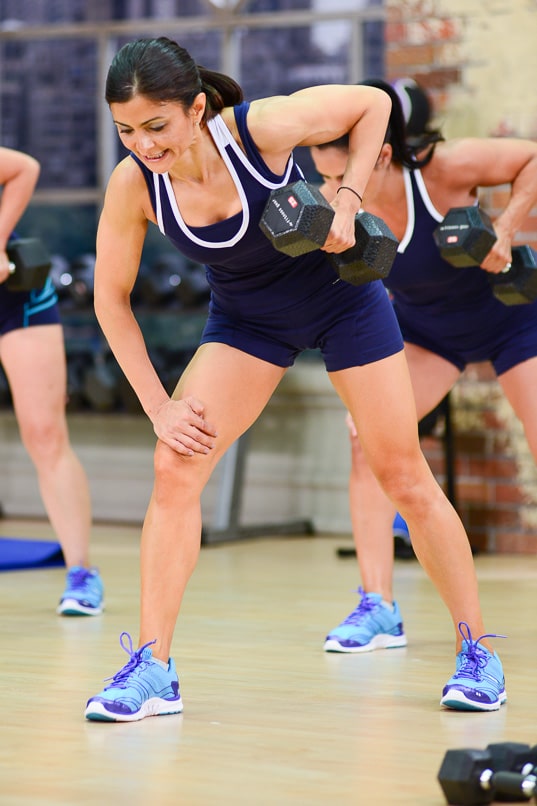
One of the best ways to reduce bone loss is by stimulating your bones through exercise. High-impact aerobic and power exercises like plyometrics are both effective for boosting bone density, but resistance exercise provides a stimulus for bone growth too. Of course, holding a pair of two pounds weights that are easy to lift won’t be enough of a stimulus to boost bone growth. How hard do you have to lift to maximize bone health?
Resistance Training and Bone Health: How Resistance Training Boosts Bone Growth
How does resistance training stimulate bone growth? When you contract a muscle it pulls on the tendon. In turn, this places force on the bone attached to the tendon and bends the bone slightly. If the force is sufficient and the bone bends enough, bone remodeling will occur as cells called osteoblasts lay down new collagen tissue, mostly on the outer surface of the bone. This collagen becomes mineralized so it’s firm and rigid and the entire bone becomes stronger and more resilient to injury. Just as muscles hypertrophy in response to resistance training, bones can also lay down new tissue.
How Much Load Do You Have to Apply to Stimulate Bone Growth?
Of course, light exercise isn’t enough to wake up the osteoblasts and motivate them to lay down new bone. There’s a certain threshold force you have to apply to the bone to kick start this process. This is called the minimal essential strain or MES. If you apply a force that’s greater than the MES to a bone, it will cause osteoblasts to lay down new collagen. That’s good for bone health.
The amount of force you have to apply to get it to grow is about one-tenth the force that would cause the bone to fracture. That means you’ll have to supply a fairly substantial amount of force to the bone to cause it to grow. Muscle endurance workouts where you’re lifting lighter weights for multiple reps generally don’t offer enough of a stimulus for bone growth since it doesn’t exceed MES. To stimulate bone growth, you need to apply a load that’s about 80 to 90% of your one-rep max. You also need sufficient volume – three sets of 8 to 10 reps for bone growth. This is similar to the force and load you apply to hypertrophy the muscle too. So muscle hypertrophy workouts provide enough stimulus to lay down new bone.
Compound versus Isolation Exercises
Compound exercises that apply force to multiple muscle groups are best for building bone. With compound exercises, you place force on multiple muscle groups and the underlying bones and these forces are transmitted to the bones in the hip and spine. That’s where you want to maximize bone density to reduce the risk of hip fractures and compression fractures. Good exercises for boosting bone growth include weighted deadlifts, squats, military, and bench press.
Just as you have to progressively overload muscles to cause them to hypertrophy, you need progressive overload for bone growth. As with all stimuli, your body adapts and you need to increase the load to continue to apply the minimal stimulus the bone needs to lay down new bony tissue. It’s also important to vary the exercises you do. This can be as simple as varying your stance when you do squats to change how force is applied to the bones.
Is It Ever Too Late to Start?
Resistance training will improve bone density most in younger women but there’s evidence that even in elderly women, resistance training helps to preserve bone density. Plus, it helps with balance – and that reduces the risk of fractures due to falling. At the same time, resistance training reduces the loss of muscle mass with age. Of course, resistance training is just one part of the equation when it comes to bone health. Getting enough dietary calcium and vitamin D is crucial for bone re-mineralization. A combination of a calcium-rich diet, adequate vitamin D and high-intensity resistance training can go far towards preserving bone health at all ages. It’s never too early or too late to get the benefits of resistance training.
References:
Essentials of Strength Training and Conditioning. Second edition. Baechle and Earle. (2000)
Med Sci Sports Exerc. 1999 Jan;31(1):25-30.
Related Articles By Cathe:
How Effective Is Step Training for Improving Bone Density?
If You Have Strong Muscles, Are You More Likely to Have Strong Bones?
Is Resistance Training Better Than High-Impact Aerobics for Bone Health?
Are Certain Types of Exercise Bad for Bone Health?
The 3 Best Types of Exercise for Bone Density and Health
How Resistance Training Shapes Tissues Other Than Your Muscles
Related Cathe Friedrich Workout DVDs:
STS Strength 90 Day Workout Program
All of Cathe’s Strength & Toning Workout DVDs
Total Body Workouts
Lower Body Workouts
Upper Body Workouts

